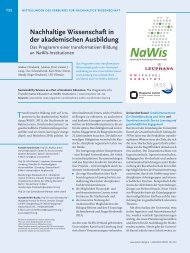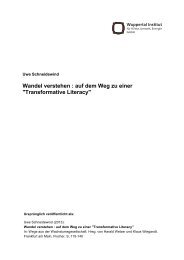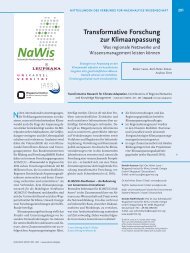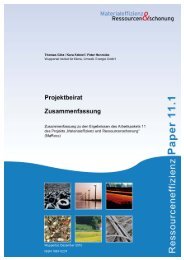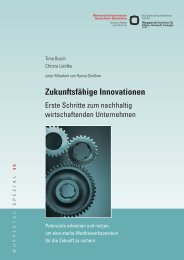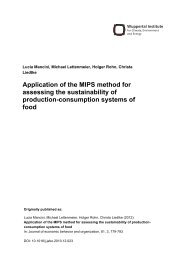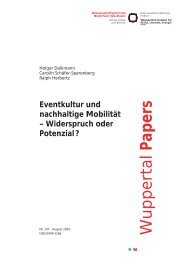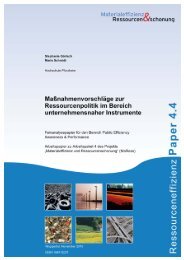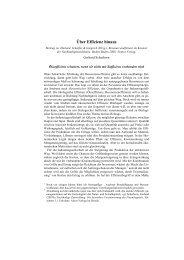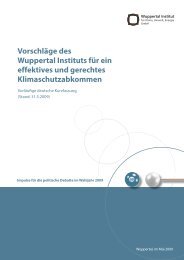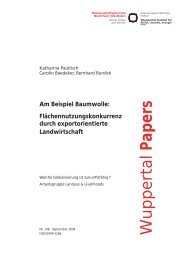Resource Efficiency Atlas - Publication Server of the Wuppertal ...
Resource Efficiency Atlas - Publication Server of the Wuppertal ...
Resource Efficiency Atlas - Publication Server of the Wuppertal ...
You also want an ePaper? Increase the reach of your titles
YUMPU automatically turns print PDFs into web optimized ePapers that Google loves.
2.2 The identification <strong>of</strong> resource efficiency examples for practical<br />
application<br />
In order to identify examples for practical application with<br />
high potential for resource efficiency, potentially interest-<br />
ing examples for technologies and products were screened<br />
(see figure 5). For <strong>the</strong> selection process a method mix <strong>of</strong> two<br />
core areas was chosen: desk research and expert involve-<br />
ment. The desk research included Internet research, analy-<br />
sis and evaluation <strong>of</strong> literature as well as statements from<br />
stakeholders. As already described in chapter 1.2, <strong>the</strong> focus<br />
was set on Europe, with additional examples from North<br />
America and Japan. The innovation- and technology anal-<br />
ysis (ITA) was used as a conceptual method (BMBF 2001),<br />
which helped identifying key questions regarding innovation,<br />
action, and future orientation.<br />
The preliminary research results provided <strong>the</strong> focal points<br />
for <strong>the</strong> expert interviews and were used for selecting relevant<br />
experts from <strong>the</strong> application, research and development<br />
fields according to <strong>the</strong> relevant topics. They were<br />
questioned about resource efficiency in specific fields and<br />
<strong>the</strong>ir exemplary application. In addition to <strong>the</strong> expert interviews,<br />
questionnaires to identify resource efficiency methods<br />
were distributed to research organisations, companies,<br />
and intermediaries in Europe and o<strong>the</strong>r selected countries<br />
(especially North America and Japan) worldwide.<br />
Next to ga<strong>the</strong>ring general information about potential<br />
examples, <strong>the</strong> questionnaire aimed at ga<strong>the</strong>ring qualitative<br />
and quantitative information on <strong>the</strong> resource efficiency<br />
potential, economically relevant information (i.e. market<br />
potential), and information on implementing resource efficiency<br />
through an assessment <strong>of</strong> risks. The questionnaire<br />
was sent to approx. 700 addresses. In response only 25 examples<br />
could be obtained, from which only 16 were relevant<br />
for <strong>the</strong> <strong>Resource</strong> <strong>Efficiency</strong> <strong>Atlas</strong>. Simultaneously, in<br />
order to obtain examples for <strong>the</strong> atlas, flyers were actively<br />
distributed during scientific conferences and o<strong>the</strong>r pr<strong>of</strong>essional<br />
events in Germany as well as in Europe or generally<br />
via <strong>the</strong> website www.wupperinst.org/rea.<br />
To fur<strong>the</strong>r increase <strong>the</strong> amount <strong>of</strong> examples, a “Call for<br />
Posters“ was organised during an international conference<br />
in September 2009 aimed at exchanging resource efficiency<br />
examples. As result four additional examples could be<br />
collected, from which only two were <strong>of</strong> sufficient relevance<br />
for <strong>the</strong> <strong>Resource</strong> <strong>Efficiency</strong> <strong>Atlas</strong>. In order to guarantee <strong>the</strong><br />
multitude and versatility <strong>of</strong> examples in <strong>the</strong> atlas <strong>the</strong> project<br />
partners researched and prepared additional examples<br />
<strong>the</strong>mselves. Here <strong>the</strong> coverage <strong>of</strong> different technological<br />
fields, different technologies, results <strong>of</strong> <strong>the</strong> expert interviews,<br />
a review <strong>of</strong> <strong>the</strong> European technology platforms and<br />
literature were considered.<br />
Method for ga<strong>the</strong>ring examples<br />
for resource efficiency<br />
Production and consumption are <strong>the</strong> key drivers <strong>of</strong> global<br />
resource requirements. Therefore, <strong>the</strong> focus <strong>of</strong> <strong>the</strong> <strong>Resource</strong><br />
<strong>Efficiency</strong> <strong>Atlas</strong> project is not only on research <strong>of</strong><br />
technologies, but also on products and broadly applicable<br />
strategies. Based on <strong>the</strong> previously systemized search fields<br />
and research results <strong>the</strong> following additional subcategories<br />
were identified (see figure 6).<br />
Selection and description <strong>of</strong> <strong>the</strong> examples<br />
The results <strong>of</strong> <strong>the</strong> screening process (approx. 350 exam-<br />
ples) were evaluated. Relevant examples (21 cases) were<br />
selected for this publication as well as for <strong>the</strong> Internet (approx.<br />
90-100 cases). All examples were graded based on<br />
a scale from one to six, where one represented best suitability<br />
for <strong>the</strong> atlas. This meant, <strong>the</strong> following criteria were<br />
considered: high potential for resource efficiency, good<br />
informational background, economical relevance, environmental<br />
impact, feasibility and transferability. In order to obtain<br />
an unanimous rating as basis for selection, all project<br />
members conducted <strong>the</strong> grading, upon which <strong>the</strong> results<br />
were discussed.<br />
Ressourceneffizienzatlas<br />
<strong>Resource</strong> <strong>Efficiency</strong> <strong>Atlas</strong> 19



